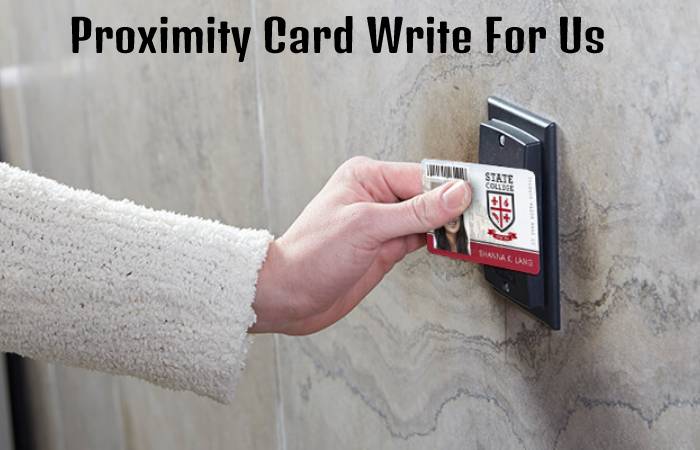Proximity Card Write For Us
Proximity Card Write For Us-We are thrilled you want to contribute your insights and expertise to proximity cards. As a platform dedicated to providing valuable information to our readers, we believe your knowledge can help educate and empower our audience. Whether you are an industry expert, a technology enthusiast, or someone with practical experience using proximity cards, we invite you to share your ideas and contribute to our community. To Write for Us, you can email us at contact@tipsfromcomputertechs.com.
What is a Proximity Card?
Cards are characterize being able to transmit data without the need to come into direct contact with the reader device. It equipped with a small specialized antenna that allows them to communicate with the reader via radio frequency. Thanks to this feature, these cards work at a distance between 4 and 10 cm so that people can carry them comfortably in their wallets.
It is common for these cards to be used for personal identification systems to control access to a venue. It is mainly because cards are made of the highest quality, resistant, and durable materials. In addition, they are highly efficient since the data is read practically instantaneously.
The operation of proximity cards is quite simple. They are equipped with a radio frequency antenna which stores the data and produces a signal the reader receives. The information is read and processed once the reading apparatus gets the call.
Undoubtedly, these cards are increasingly gaining popularity and being adopted by various companies, businesses, and establishments.
Advantages of Proximity Card Write For Us
Having understood what a proximity card is, you wonder about its advantages. The reality is that they provide many benefits, such as:
They do not wear out over time. Conventional chip cards wear out quickly from frequent use, causing them to deteriorate over time. It is because traditional chip cards come into contact with the reading devices through friction, and said friction wears out the chip’s functionality to transmit the information.
They do not lose the encoding. On magnetic stripe cards, the encoding deteriorates and wears out over time; but this does not happen with these cards. So when we talk about what a proximity card is, we are also referring to a card with an encoding that has a long duration (if not infinite).
They are cheap. Suppose we balance the price of proximity cards and all its security and durability benefits. In that case, it is undoubtedly a card with an excellent price-quality ratio. Generally, a proximity card can cost between 1 and 5 euros, a more than affordable price.
Use Proximity Cards
There are a wide range of uses for proximity cards, and some of the most common are:
As a personal identification card, knowing what a proximity card is and how it can transmit information indeed highlights that it can be used as an identification card. In this way, you can regulate the entrance to private venues and events and even control the access of personnel to the facilities of a business or company.
On public transport. Many transport companies (whether bus, metro, uber, etc.) use proximity cards to measure the number of trips a person makes. People can continue using transport services through a small monetary recharge by presenting their proximity cards to the corresponding readers.
Like payment cards, payment cards that use conventional chips have the disadvantage that they quickly wear out over time due to constant friction when coming into contact with the reading devices. However, as we mentioned earlier in the section on what a proximity card is, these cards do not have this problem.
Topics We Cover
We focus on proximity cards and related technologies at tipsfromcomputertechs.com. We welcome articles, tips, and tricks covering various aspects of proximity cards, including but not limited to:
An Introduction to Proximity Cards: Explaining what proximity cards are, how they work, and their different types.
Advantages of Proximity Cards: Highlighting the benefits of using proximity cards in various applications, such as access control, time tracking, and secure identification.
Tips for Effective Implementation: Offering practical advice on deploying proximity card systems, managing access levels, and ensuring security.
Integration with Other Technologies: Discuss how proximity cards integrated with biometric scanners, , and visitor management software.
Best Practices for Proximity Card Security: Sharing tips on safeguarding proximity card data and preventing unauthorized access.
Troubleshooting Common Issues: Offering solutions for everyday problems users may encounter with proximity cards and their readers.
Innovations and Trends: Exploring the latest advancements and trends in proximity card technology and their potential impact on various industries.
How to Submit Your Articles and Write For Us
To submit guest posts, please study through the guidelines mentioned below. You can contact us finished the website contact form or at contact@tipsfromcomputertechs.com
Why Write for Tips From Computer Techs – Proximity Card Write For Us

- If you write to us, your business is targeted, and the consumer can read your article; you can have huge exposure.
- This will help in building relationships with your beleaguered audience.
- If you write for us, the obvious of your brand and contain worldly.
- Our presence is also on social media, and we share your article on social channels.
- You container link back to your website in the article, which stocks SEO value with your website.
Search Terms for Proximity Card Write For Us
- Proximity card reader
- RFID card
- Access control card
- Key card
- Smart card
- Contactless card
- Proximity badge
- Proximity token
- Proximity fob
- Proximity key tag
- Proximity credential
- Proximity access device
- Proximity transponder
- Proximity interrogator
- Proximity coupler
- Proximity antenna
- Proximity transceiver
- Proximity tag reader
- Proximity tag encoder
- Proximity tag programmer
- Proximity tag management
- Proximity tag security
- Proximity tag applications
- Proximity tag market
- Proximity tag trends
Search Terms for Write For Us
Proximity Card Write for Us
Write for Us Proximity Card
Proximity Card Guest Post
Guest Post Proximity Card
Proximity Card Contribute
Contribute Proximity Card
Proximity Card Submit Post
Submit Post Proximity Card
Proximity Card submit an article
Submit an article Proximity Card
Proximity Card become a guest blogger
A guest blogger Proximity Card
Proximity Card writers wanted
Wanted writers Proximity Card
Proximity Card suggest a post
Suggest a post Proximity Card
Proximity Card guest author
Guest author Proximity Card
Article Guidelines on Tips From Computer Techs – Proximity Card Write For Us
- The author cannot be republished their guest post content on any other website.
- Your article or post should be unique, not copied or published anywhere on another website.
- The author cannot be republished their guest post content on any other website.
- You cannot add any affiliates code, advertisements, or referral links are not allowed to add into articles.
- High-quality articles will be published, and poor-quality papers will be rejected.
- An article must be more than 350 words.
- You can send your article to contact@tipsfromcomputertechs.com

